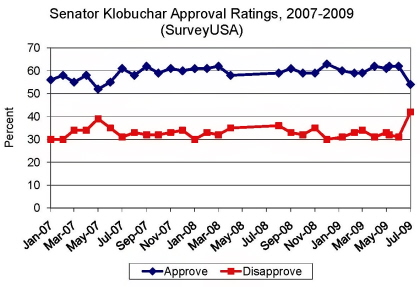Et Tu Minnesota? Klobuchar Disapproval Rating Soars to Record High After Franken Is Seated

One of the few Senators left seemingly unscathed by this backlash of public opinion against its leaders in Washington, D.C. was Minnesota senior Senator, DFLer Amy Klobuchar.
Minnesotans showed particular good will towards Klobuchar during these trying times while other Senators were enduring low public approval ratings across the country. This good will may have been due, in part, to Senator Klobuchar’s toiling, without much complaint, under a double-duty constituency caseload as the Gopher State slogged through the legal proceedings in the 2008 U.S. Senate contest between Norm Coleman and Al Franken.
However, just a few weeks after Franken was seated as Minnesota’s junior Senator in early July, Klobuchar’s approval rating dropped by a significant amount, and her disapproval rating increased by double digits in one month. (As had happened to many of her colleagues earlier in the year).
In short, with the Gopher State now at full representation in D.C., Senator Klobuchar seemed to no longer be insulated from the public discontent with the problems facing Minnesota and the country.
According to SurveyUSA’s latest round of monthly polling, Klobuchar’s approval rating fell from 62 percent in June to 54 percent in mid-July – her second lowest mark of her D.C. career, behind only the 52 percent she notched in a May 2007 SurveyUSA Poll.
Even more striking, 42 percent of Gopher State residents disapproved of the job Klobuchar is doing as Senator – her highest red mark ever and the first time that number has reached the 40 percent mark in her 2.5 years on the Hill. Klobuchar’s disapproval rating increased 35.5 percent in just one month: from 31 to 42 percent.
While it is dangerous to read too much into one poll, it is important to note, as Smart Politics reported earlier this year, Klobuchar’s numbers had previously remained remarkably flat over the course of her tenure in Washington in poll after poll.
In 22 consecutive polls conducted by SurveyUSA between July 2007 and June 2009, Klobuchar’s approval rating had a variance of just 5 points – falling between 58 and 63 percent in every survey. Similarly, her disapproval rating had been measured between 30 and 36 percent in every SurveyUSA poll during this two-year stretch.
The fact that Klobuchar’s approval rating should dip to its second lowest level, and her disapproval rating reach an all-time high, in the very first month in which Al Franken officially became her colleague in D.C. is ‘curious’ at the very least.
As a result of this apparent shift in public sentiment, Klobuchar has now endured the 4th largest drop in net approval rating since Barack Obama took office in January of this year among the 25 Senators tracked by SurveyUSA.
Fellow Upper Midwesterner Herb Kohl (D-WI) has seen the biggest net drop, at minus 23 points during this span.
Overall, these 25 Senators have seen their collective +24.8-point net approval rating in January fall to +14.2 points in July.
But this growing disapproval by the public toward the job its Senators are doing in Washington has not been evenly distributed between Democrats and Republicans. The Republicans have seen their net approval rating drop an average of 6.6 points from January to July, while the Democrats have seen their net approval rating drop nearly twice that amount at 12.5 points. (SurveyUSA tracks the approval rating of 8 GOP Senators and 17 Democrats).
Decline in Net Approval Rating Among U.S. Senators, January – July 2009
|
State
|
Senator
|
Party
|
Jan-09
|
Jul-09
|
Change
|
|
WI
|
Herb Kohl
|
Dem
|
+37
|
+14
|
-23
|
|
NM
|
Tom Udall
|
Dem
|
+39
|
+19
|
-20
|
|
OR
|
Ron Wyden
|
Dem
|
+37
|
+19
|
-18
|
|
MN
|
Amy Klobuchar
|
Dem
|
+29
|
+12
|
-17
|
|
IA
|
Charles Grassley
|
GOP
|
+49
|
+32
|
-17
|
|
KS
|
Pat Roberts
|
GOP
|
+31
|
+16
|
-15
|
|
WA
|
Maria Cantwell
|
Dem
|
+23
|
+8
|
-15
|
|
VA
|
Mark Warner
|
Dem
|
+47
|
+32
|
-15
|
|
NY
|
Chuck Schumer
|
Dem
|
+36
|
+22
|
-14
|
|
WA
|
Patty Murray
|
Dem
|
+19
|
+5
|
-14
|
|
WI
|
Russ Feingold
|
Dem
|
+30
|
+17
|
-13
|
|
MO
|
Claire McCaskill
|
Dem
|
+13
|
0
|
-13
|
|
NM
|
Jeff Bingaman
|
Dem
|
+37
|
+24
|
-13
|
|
KY
|
Jim Bunning
|
GOP
|
-1
|
-12
|
-11
|
|
VA
|
Jim Webb
|
Dem
|
+19
|
+11
|
-8
|
|
CA
|
Diane Feinstein
|
Dem
|
+20
|
+12
|
-8
|
|
MO
|
Kit Bond
|
GOP
|
+24
|
+16
|
-8
|
|
NY
|
Kirsten Gillibrand*
|
Dem
|
+8
|
+1
|
-7
|
|
CA
|
Barbara Boxer
|
Dem
|
+14
|
+8
|
-6
|
|
OR
|
Jeff Merkley
|
Dem
|
+8
|
+3
|
-5
|
|
IA
|
Tom Harkin
|
Dem
|
+25
|
+21
|
-4
|
|
AL
|
Jeff Sessions
|
GOP
|
+31
|
+29
|
-2
|
|
KS
|
Sam Brownback
|
GOP
|
+18
|
+16
|
-2
|
|
AL
|
Richard Shelby
|
GOP
|
+31
|
+31
|
0
|
|
KY
|
Mitch McConnell
|
GOP
|
-4
|
-2
|
+2
|
|
|
Average
|
|
+24.8
|
+14.2
|
-10.6
|
* Approval rating begins in February 2009 when Gillibrand took office. SurveyUSA data compiled by Smart Politics.
The same SurveyUSA poll also measured an all-time low in approval rating statewide for Barack Obama, and, more importantly, a four-year high in Republican Party ID.
As such, the big question is whether there is real movement towards the GOP in the Gopher State or whether a higher than normal sampling of Republicans in the poll’s respondents (though within the margin of error) is driving these numbers.
Follow Smart Politics on Twitter.


I’ve been subscribed to this blog for almost a year now and it’s been interesting seeing the times the analysis is spot on and the times where it’s been flat-out wrong. Either way, the thoughts here have been generally founded on good data and there’s usually an attempt to frame things objectively.
This post, on the other hand, is horrible. Even though everything you say may be technically correct, your political framing to imply Franken is responsible for Klobuchar’s approval numbers, especially after you show that it’s statistically unfounded with Klobuchar matching the trend of approval and disapproval ratings of other Democrats is disingenuous at best. Regarding this paragraph:
What is so statistically, intellectually or factually “curious” about this? Are you really saying that Franken being seated hurt most Democrats’ approval ratings? Why did Franken hurt Herb Kohl and Tom Udall more than Amy Klobuchar then? How do figure that Franken has more of an impact on Klobuchar’s approval and disapproval when there’s government bailouts, the seating of a new supreme court justice and loads of other news and votes that may actually impact people’s impression of Klobuchar directly? If Franken wasn’t seated, are you implying Klobuchar’s ratings may not fallen in a way that they did for her peers? I’m “curious” too.
Again, the post above may be factually correct, but it’s the bizarro political framing that’s reminiscent of Fox News, not something I’d expect from the University of Minnesota.
Trickle down economics is what the Democrats are suffering from. It is the gift that keeps on giving… Until the economy recovers and jobs are being created, the Dems will see numbers go south.
The upside is that the economy is and will recover. Unfortunately what the “new economy” will look like will not be what the previous economy looked like. The former economy was unsustainable with everyone being all levered up on credit. As such the Dems will “eventually” get credit when this does turn around. The real question is whether it will turn around enough to have a meaningful impact in 2010.
> What is so statistically, intellectually or factually “curious”
> about this? Are you really saying that Franken being seated
> hurt most Democrats’ approval ratings? Why did Franken
> hurt Herb Kohl and Tom Udall more than Amy Klobuchar
> then?
As I wrote in the blog, the reason I do not attribute any statistical significant to Franken’s impact on the approval rating of other Senators, is that their approval ratings (including Kohl and Udall) had dipped much earlier in the year (see links embedded in the blog to past research on this topic).
The difference, as I wrote in the 4th paragraph below, is that Senator Klobuchar did not suffer any effects of this public disapproval until she stopped working a double-duty constituency caseload (i.e. when Franken was seated). As I wrote:
“In short, with the Gopher State now at full representation in D.C., Senator Klobuchar seemed to no longer be insulated from the public discontent with the problems facing Minnesota and the country.”